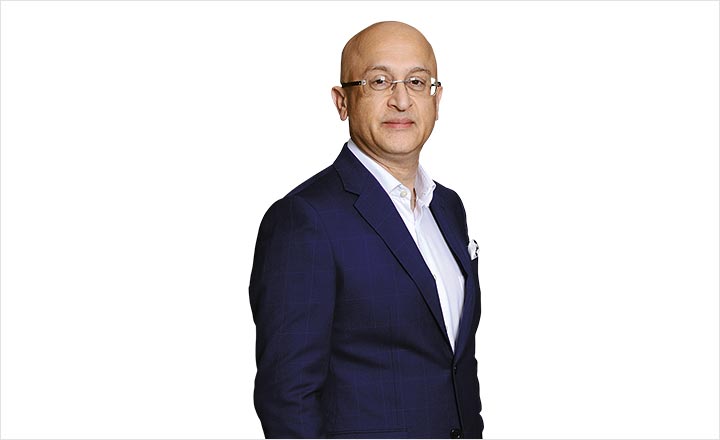Outlook Business: The view that has emerged thus far is that the macros are looking good from a two- to three-year perspective, but there is nothing which indicates that
everyone is confident that this is going to be a great year. Am I correct?
Hansraj: I am not thumping the table and saying that this year is going to be a great year. My gut is that Q2 is not going to be hunky-dory. Will it change in Q3 or Q4? My sense is that, it will. But right now, it's just a conjecture.
OB: So, fundamentals are on a weaker footing but liquidity is what is pushing the market up…
Saluja: Liquidity is not the driver because domestic institutions and FIIs anyway used to invest $20-25 billion a year. This time around its domestic money that is around $10.3 billion. It is just that the composition of money flow has changed.
OB: So, it’s all about domestic liquidity now?
Saluja: The composition of money flow has changed and that is good for India. We have always been vulnerable to funds from abroad and every time they would exit, the market would correct. India has to now focus on channelising its household savings. People are realising that equity is a better asset class. So, the percentage of equity to household savings has to go up. The fact that today domestic liquidity is keeping the market up is a great sign for India.
OB: That’s precisely what my next question is: what is the nature of this liquidity and will it sustain?
Hansraj: A lot of money is moving away from fixed income and real estate into equity.
OB: Is it structural or cyclical, as the market is doing well?
Hansraj: Last month, MF inflows were almost Rs.20,000 crore, which is close to $3.5 billion. That’s staggering because what you saw whole of last year is less or just about equal to this number. Where is it coming from? As I said that 6% pre-tax on deposits is equal to sub-4% post-tax, and 4% is the inflation number. This means that, effectively, keeping money in a deposit today is just about beating inflation or equalling inflation. So, there is money moving out. Real estate hasn’t made money for the past four-five years, so there is money moving out from this asset class as well.
Saha: We are indeed seeing a structural shift towards equity from fixed income and also because of the different PMS products that the industry itself is promoting. But a change of sentiment can stall this momentum. For the past three years, we have benefited out of the optimism around the government and from the liquidity. Because the valuation is fair, people will start booking profit as the market starts moving up.
Papneja: The point that I was trying to make earlier is that a chunk of the Rs.20,000 crore inflow that we have seen, assuming that’s the average per month, could see a pause in the event of a sentiment change. We are seeing that behaviour among the HNIs who are comfortable coming back [even if stock prices rise] 3-4% higher. The complacency, which I said is something to worry about given the multi-year lows of global and Indian VIX indices, also gives you opportunity on the other side. For instance, complacency is giving you an opportunity to buy a three-year put at 5%, you can’t get 3-year insurance at 5% — this is unheard of. The low volatility is resulting in lower put option premiums. To protect your portfolio, for example, a three-year put option for 10,000 Nifty series, is available for Rs.500-Rs.550.
Hansraj: That too when a 3-year call is available at 22-23%. In essence, a three-year call for 10,000 Nifty series is quoting at Rs.2,200-2,300 level.
Umang: So, what we are saying is that, if there is this kind of complacency, how do you use it your advantage and, in case, this complacency breaks, are we protected or not. So, in essence, we would be buying puts at this point in time along with equity.
Rao: Incidentally, the past six months has seen a new set of super-rich investors engaged in real estate, lease rental discounting, who are like saying, "I want to put in Rs.100 crore in equity, tell me which mutual fund to invest in?" So, the quality of money that is coming in is new. And as Umang is pointing out that complacency has taken the money in, so that is the part to be worried about.
OB: So, is that liquidity really stable and sustainable?
Saluja: Despite the fact that for three years, earnings have been dismal, the market hasn’t come down meaningfully. Every time there is a correction, people are waiting to buy, and we are not even talking about FII flows. This year, thus far, FIIs have pumped in only $5 billion, as they have been investing in the US and Europe. But if you talk of 6-7% growth, FII money has to ultimately chase India. The moment the market corrects, you will suddenly find FII money rushing in. If earnings get further disrupted, one can expect a 5-10% downside and if BJP loses in Gujarat, it can result in another 5% dip.
OB: If BJP loses then that can be a big negative...
Rao: If jobs are not created, people are not going to vote, it has happened before. If that happens, 2019 may turn out to be a crucial year. Old money, however, will be able to take a comfortable decision, but it’s the new money which will have a challenging time out there.
Gumastha: Over the past three years, close $35 billion of FDI has been coming in every year. So, what is this government projecting? It is suggesting that if you invest in this country we will ensure a stable environment. We are projecting a stable currency and an inflation rate which is under control; a fiscal deficit which is well within range. So, all of these will bring in a lot of foreign capital into the country. India as an investment destination will continue to attract capital. If you see, globally, pension funds have a problem of return. And the only two engines of growth in the world right now are China and India. While China will continue to grow, India ensures a fairly transparent growth environment. Also the financialisation, which is underway, is going to continue because of the Rs.7.6 trillion savings pool, only 4% is in equity.
OB: Why should this financialisation stay for good because demonetisation was an one-time affair?
Hansraj: About $60 billion (Rs.380,000 crore), which was theoretically in the cupboards of wives, mothers and daughters, has entered the banking system. If that number is right and assuming a money multiplier of six times, we are talking of one third of a trillion. That’s a big number and this money is not going back.
Umang: What we are seeing is that younger people don't want to buy real estate. Demonetisation may have hastened the process but the change is structural. For example, eight years ago, our clients used to be in the age group of 40-50, now they are more in the age bracket of 20 to 30, and 30 to 40. These folks don't want to buy real estate. So, the demographic effect is in play and will continue to influence the financialisation process.
OB: But the housing loan market is quite vibrant, everybody wants a piece of the housing loan pie?
Das: You have a point, can the money move back into real estate? Yes, it can. Actually post demonetisation in the last quarter, stamp duty collections were up. Now, that’s a very interesting data point. We have to wait for more data points to look at whether that impact has faded away.











